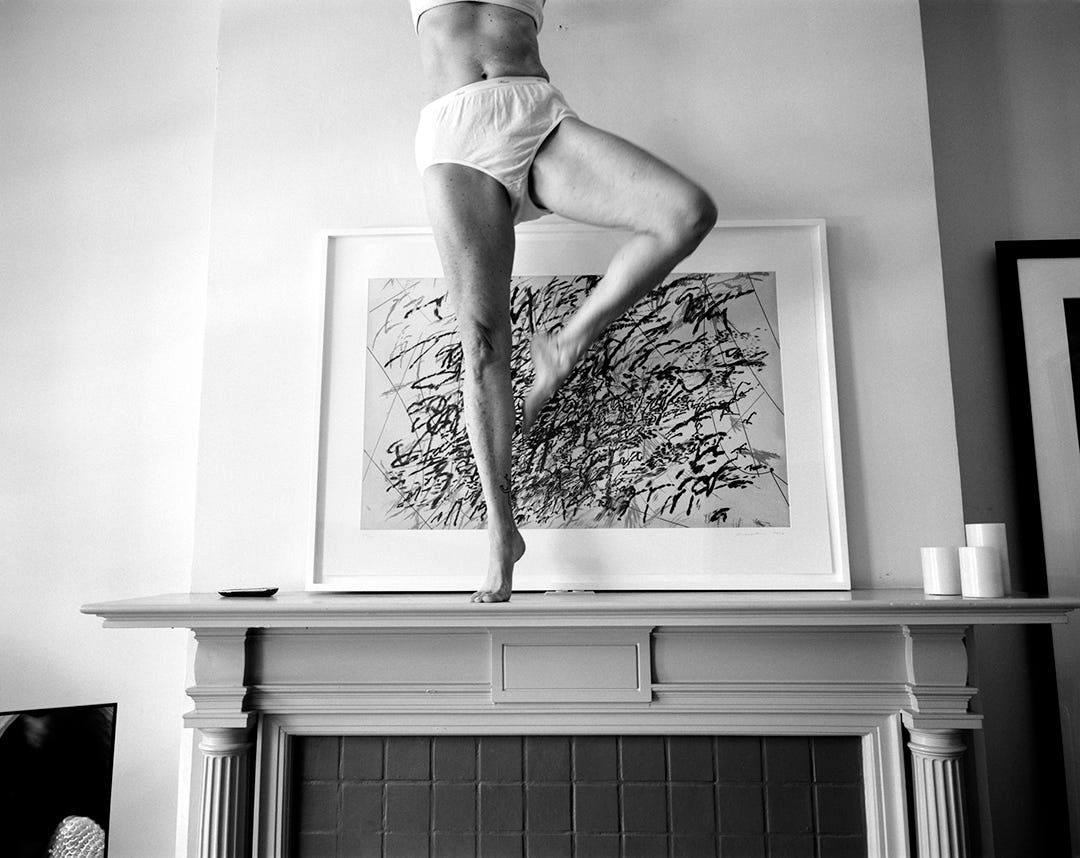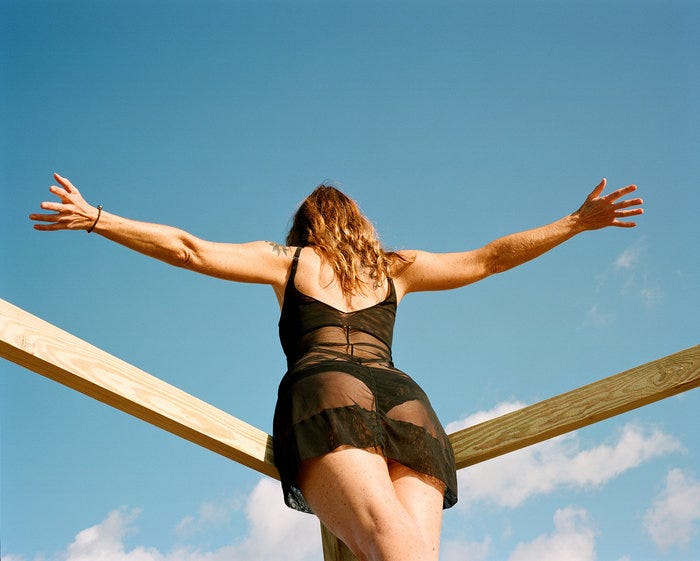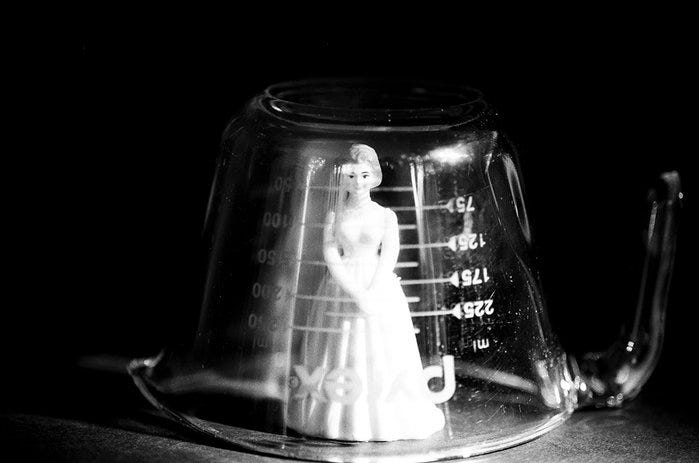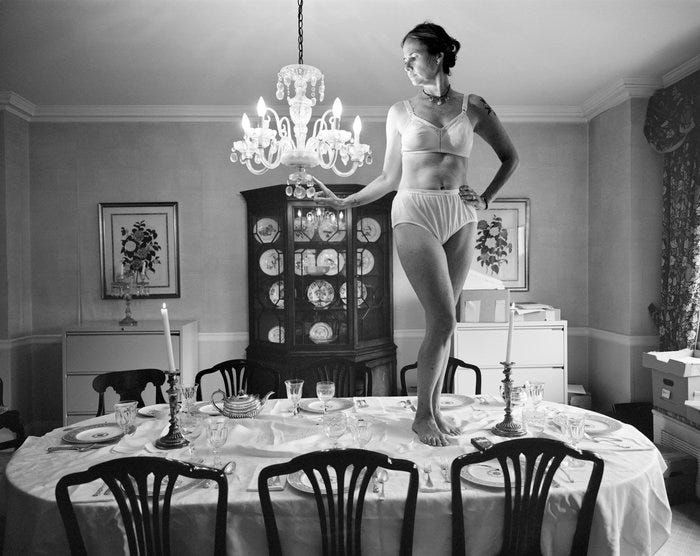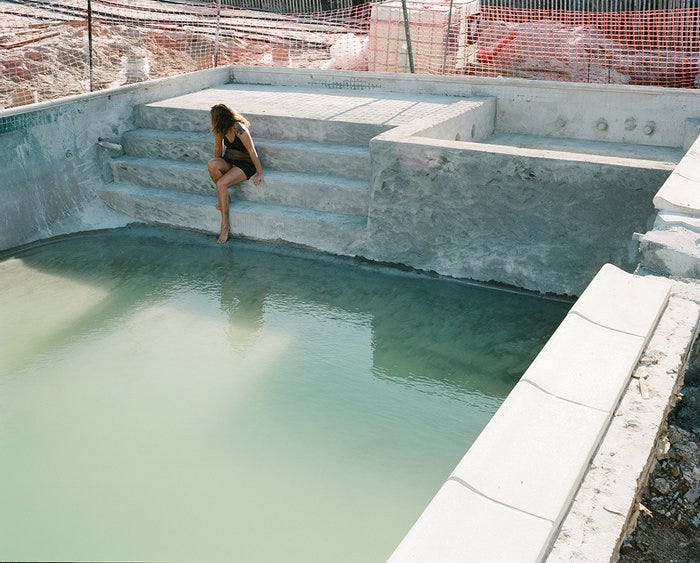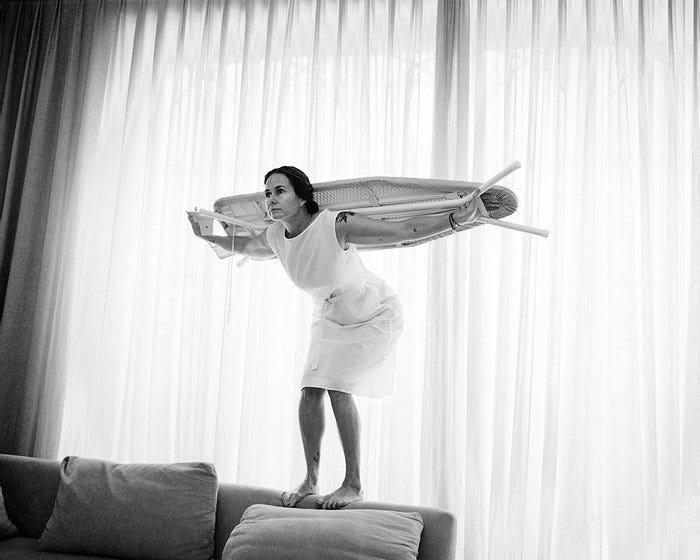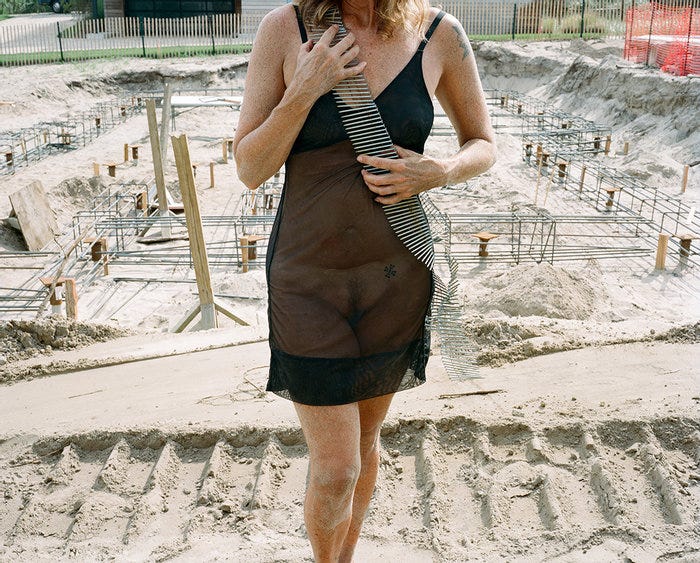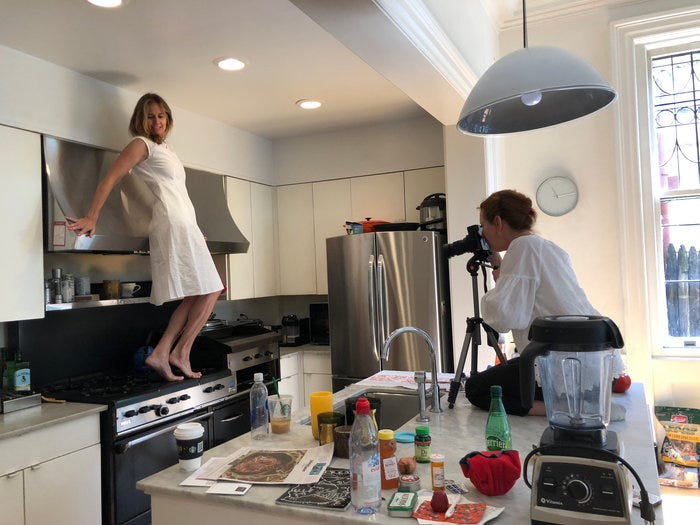1/6/21
One of the concepts I taught in Middle School English is the distinction between internal and external conflict. Conflict is internal if a character is battling an obstacle from within -- when they lack courage or fear intimacy. Characters facing outside forces like storms and enemies have exterior conflicts. Complex characters wrestle with both.
When I was in my 20s and struggling with writing, my obstacles were self-imposed, the internal kind. No one was out there telling me I couldn't write because I was a straight, white, Jewish woman. I stopped writing for 20 years because I convinced myself I had nothing to say, caving to the kind of self-destructive thinking that undermines countless writers. I remember reading Phillip Roth's American Pastoral and thinking, what's the point?
In the art world, women with children often face obstacles fueled by internal and external conflicts -- both the noises in their head and external voices devaluing their work because they are mothers.
I wasn't aware of this stultifying dynamic until I watched the 2018 KCET documentary Artist and Mother. In the film, curator Helen Molesworth notes, "In Western civilization, we have this idea of an artist … This person is almost always considered a white man, and he is a genius, and he will do anything for his art." I am guilty of this kind of thinking. I've always put artists on a pedestal, buying into the idea of the drunken, tortured, womanizing genius.
"A mother, on the other hand," says Molesworth, "...gives up everything, but she does so in the guise of selflessness." This is the message the art world conveys to women: you can be a good artist or a good mother, but not both. I've never heard a woman outside of the art world say that being successful and being a mother are inherently incompatible.
Yet this mindset can easily undermine women artists. They get dropped from galleries when they become pregnant and fear their work will be relegated to mommy art. It's why we so rarely see motherhood represented in fine art. (Besides Mary Cassatt, how many modern artists can you name who address motherhood in their work?) It's why in a 2020 podcast called "How to Nix the Haters, Make the Work & Shake the Guilt," the artist Kate Sable calls pregnancy a "dirty little secret" and describes being met with "underhanded, subtle toxicity" at her gallery opening. Although Sable acknowledges progress in the art world in the past decade, she maintains it still has "a lot of catching up to do."
Born in the mid-1960s, Margaret Reid Boyer and Jodie Factor were wrestling with the mother/artist conflict two decades before Sable. Their photos reflect the traps that women of my generation ironically fell into. We had more educational, social, and career options than our mothers did, yet we made many of the same choices around marriage and family.
I love how Reid+Factor upend the ways women are traditionally objectified. A man hasn't taken photos of a naked woman -- another woman has. A transparent black slip gets flipped from sexy lingerie to guerilla garment.
Margaret and Jodie are also not afraid to expose the confines of domesticity. "Mad Habitat" presents a narrative about a woman alone in her home, sometimes naked, sometimes in matronly underwear. As she interacts with her oppressors, the furniture, appliances, and cleaning tools that keep her from freedom, her moods shift: mordant, inquisitive, playful, overwhelmed. She does headstands. Peers behind wallpaper. Tip-toes across her headboard. When she puts her head in the dryer, it's hard not to think it could be her oven. She imagines an ironing board as wings. Is she attempting to fly the coop? Looks like it. Or is she just testing her boundaries?
In the subsequent series, "She Became A Kingdom," walls and conventions no longer contain the woman. Free in a new, possibly post-apocalyptic world, survival has superseded housework. As she explores her new surroundings, testing and claiming the land and structures, she is contemplative, resourceful, powerful, and triumphant.
Given Reid+Factor's focus on women's experiences, the absence of children in their images is surprising. We talked about this in the following interview, and the discussion made me think about what the artist Rebecca Campbell states in the KCET movie, "I'm hesitant to be in a documentary about women artists who are mothers."
Of course. Just as someone may not want to be solely identified by sexual orientation or race, not every woman wants her work to be associated with motherhood. Women should be free to capture the experience but never obligated. As you dig into Reid+Factor's work, look for other ways they subvert expectations and representations of women.
You met in grad school at the School of Visual Arts in 1995 and began your collaboration in 2017. How did that come about?
MARGARET: It was a lark. I asked Jodie to look at a project I was having trouble with, and her suggestions were so good that I asked if she’d be interested in working on it together. Because creating art is so personal, it never occurred to me that you could do it with somebody else.
JODIE: I can't see doing it with any other person.
MARGARET: A lot of people have said things to us like, "I'm so jealous that you guys have this thing," or "How can I get a collaborator?" You can't plan it. This was organic, and we're lucky.
JODIE: You have to have a similar vision and sensibility. Because we went to graduate school together and grew out of the same school of thought, our base is the same. We're also aligned in terms of technology. We both shoot on film with a medium format camera.
MARGARET: Our collaboration has always been driven by our interests. We are excited by the same artists and are always engaged in conversation about how to express what we are going through.
JODIE: We're both trying to express the same feminist themes. After we had kids and I put my career on hold, I noticed the differential in power between men and women. I was shocked by how much work I was doing, just taking care of the kids and housework; it just didn't feel good.
You both have twins (Margaret has two sets, and Jodie has one and a third child). Do you think that shared experience is a factor in the success of your collaboration?
MARGARET: Understanding what it means to parent under those circumstances, which I often refer to as extreme parenting, means knowing that things go wrong. You have to release control and let it happen. Sometimes it's going to fail, and you just have to pick yourself up and go forward again. And there's going to be a lot of mess involved. I would say that is kind of an unspoken thing that we have together.
JODIE: Yes. We don't expect everything to go as planned. We definitely roll with the punches. Maybe that comes from extreme parenting.
What are the benefits of making art with someone versus working alone?
MARGARET: I have more freedom to generate, experiment with, and execute conceptual material, knowing there's someone who will take the heat, who has my back. Having someone there to share responsibility for the thing you're creating makes it easier to take risks. And taking risks is what making art is all about.
JODIE: In grad school, we were surrounded by people who had the same purpose. I felt supported and energized. When I went out on my own, it was hard not having that camaraderie. Our collaboration brought that energy back.
To what extent did you put your careers on hold to raise your kids? What were your respective experiences?
MARGARET: I never really stopped working before or after I had kids. That said, my husband's more lucrative career definitely took precedence. Was I resentful of that dynamic? Sometimes. Often. Having and raising kids was a priority, but I strongly resisted being solely definedby my role as a mother. There's a kind of judgment once you're pregnant or have a young child. You're no longer a player and don't have the same contribution to make because you're doing this other dirty duty. People ask about my kids but rarely about my work.
JODIE: I was working at the Associated Press and later a photo agency. I stopped working after having kids, and in rare moments of free time, I critiqued and helped edit other photographers' work. There was not much time for me to focus on my photography, and I don't think I would've had the bandwidth. I remember being frustrated that I couldn't do it all, but that bitterness is gone. Now that I'm past the physical part of being a parent, I feel like my mind is more open to being creative.
MARGARET: I see the art that we make together as a triumph or payoff after years spent in the relatively thankless (and individuality erasing) arena of caring for young kids. But even though the hard labor of motherhood is complete, the imbalance of power and its effects remain omnipresent.
"Mad Habitat" has a 1950s American housewife, "Leave it to Beaver" kind of vibe. Was that your intention?
MARGARET: We had several timeframes in mind that we wanted to reference: the 1950s, the late 1800s Victorian suffragette era, and the current day.
JODIE: We wanted it to be timeless to show that things haven't changed that much.
How come there is no evidence of Mrs. Cleaver’s kids?
MARGARET: We intentionally abstracted the images to allow them to be less specific to my life or Jodie’s.
JODIE: Markers of family would weigh down the fantasy aspect.
MARGARET: We want the work to reflect a broader spectrum of female identity. While motherhood is inextricably linked to issues of feminism and the power structure in our culture, our work isn’t defined by motherhood.
Given the challenges of being an artist and a mother, what advice would you give an artist who is about to have a baby?
MARGARET: You can do this work forever. There is no time limit or expiration date on being an artist. If you need to take a break, take a break. You can make art at any stage of your life. You can make art about any stage of your life, whether you're nursing an infant or using a walker to get down the street.
JODIE: All life experience, especially motherhood, only enriches your art, no matter what kind of art you make.
How different is the dynamic in your collaboration from the dynamics of your marriages?
MARGARET: You don't have the issues of who's making money and who's not. There’s no financial pressure to support a family. Also, divisions of power don't play into our relationship, which is a beautiful thing. You don't have one person who's taking care of all the crap duties.
JODIE: Our partnership is truly a partnership. It’s smoother. The shared duties and camaraderie make all the dirty work seem not that bad. There’s so much more to do than just the pictures: the rent, the studio, printing, sending out mailings, framing, applications for shows and grants.
MARGARET: Ultimately, we are different people with different strengths that support each other. Since Jodie's more gracious and has a way of making people feel comfortable, she does a lot of phone calls.
JODIE: Our skills dovetail really well. Margaret is a brilliant writer, so when we work together, coming up with artists' statements or presentations, she can take my words and make them sound beautiful and make sense.
Does your relationship ever get competitive?
MARGARET: When we were in grad school, you could sense some competition among artists; some people were "borrowing" ideas from others. But with Jodie and me, there was never any of that. It's always been a back and forth. There are no power issues.
JODIE: I hate to say it after working in the corporate world and seeing competition unfold firsthand: it might be a very feminine thing to honor somebody else's idea and support it.
MARGARET: Every once in a while, we have a difference of opinion about, let's say, titling a picture or including a certain picture in an edit --
JODIE: We don’t have to force any ideas on each other and be the one who's right. If there's ever something that maybe one of us disagrees with, we see where it goes instead of dismissing it.
Is Jodie directing when Margaret is posing? I keep thinking of Barbra Streisand on the set of "Yentl" running to the camera in costume to check how a shot looks.
JODIE: The work is very performative, and we improvise a lot. With "Gargirrrl," Margaret was experimenting with the tutus— on her head, on her arms, and when she felt we had the right positioning, she said, "Let's try shooting this." Other ones were more me saying, "Try this," but it's not the kind of power dynamic where you have a director calling the shots and telling the actor what to do.
MARGARET: When we started with me as a character, I'd go back and check how Jodie had set the camera. But she’s so good that I don't check much anymore. There is directing that goes on as well. She'll say, "you've got to move your leg a little bit that way because it doesn't look quite right,” but it's really a give and take to see things from each other's perspective.
JODIE: We use our iPhone cameras to help guide what the shot will look like. Some, like the ironing board, we did four times. Outside. Inside. And every time we'd develop the film, we'd look at it then go back.
MARGARET: We were trying to find the best way to use the ironing board's metaphoric and visual characteristics.
How did it come about that Margaret plays the character in "Mad Habitat" and "She Became A Kingdom?"
MARGARET: We never declared that to each other. It ended up that way, in part because Jodie and I have always been about using whatever we have on hand. In our busy lives, we don't have the time to put out a Craigslist ad to find models. We often talk about bringing Jodie into the picture with me, and that may be happening next.
Do you intend to keep working with the character, and if so, where do you see her going?
JODIE: I think the answer is we don't know. The character comes out organically.
MARGARET: Inspiration for the next phase could come from anywhere - from a tear sheet in a magazine or a passage in a book one of us is reading. We just start with real kernels and then move on from there.
Do you anticipate staying together?
JODIE: It still feels fresh. We talk about future ideas we want to do after COVID is in the rear window.
MARGARET: We're still in the honeymoon phase.
And where are each of you in terms of individual work?
MARGARET: I don't do any individual work.
JODIE: Me either
MARGARET: I always had it in my mind that I would do other projects, but I haven't, and I don't miss it, not even a little bit.
